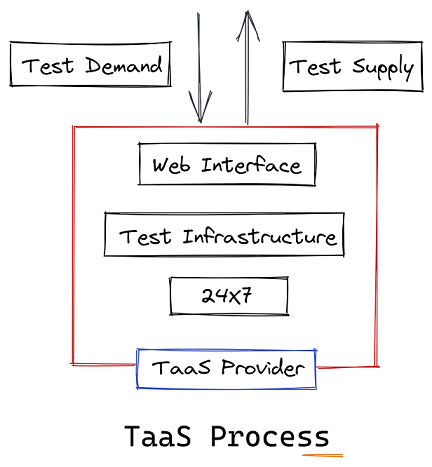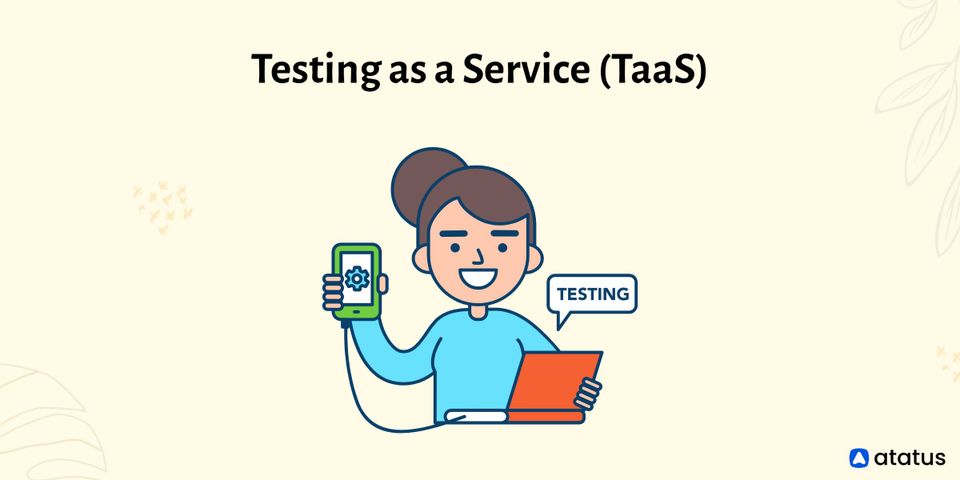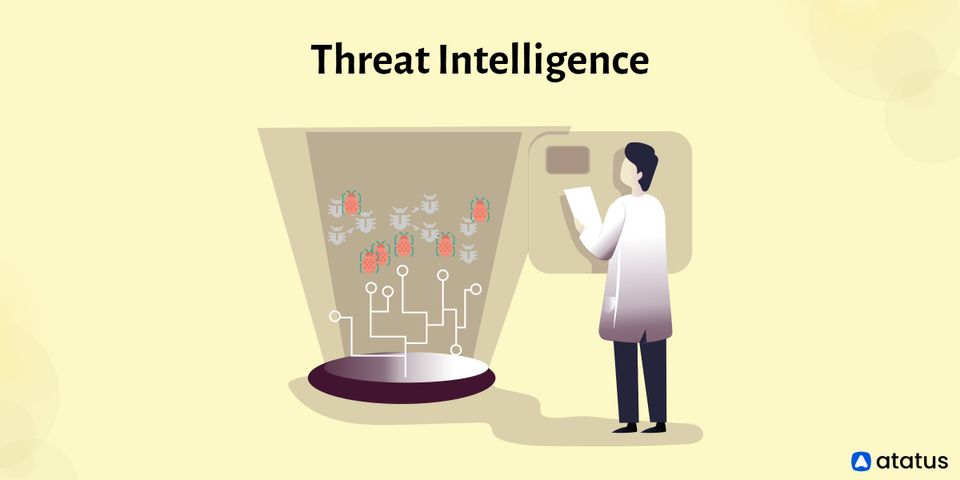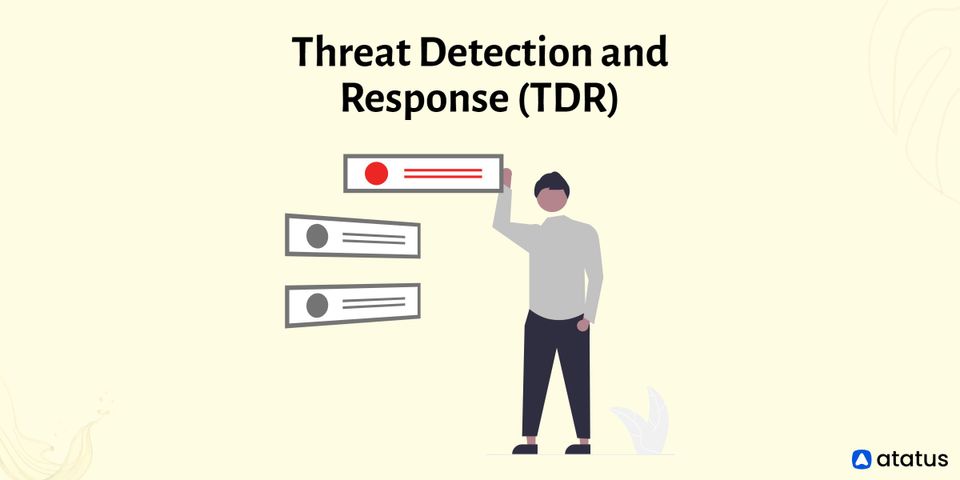Software as a Service (SaaS) has become a buzzword in the technology industry during the past two decades. Businesses have profited from the surge in interest in obtaining software that might enhance business processes. However, as the world gets smaller and more interconnected, businesses that don't want to undertake any internal software testing might benefit greatly from outsourcing and save money. Thus, the question of what Testing as a Service (TaaS) arises.
We will go over the following:
- What is Testing as a Service (TaaS)?
- How Does Testing as a Service Work?
- Classification of Testing as a Service
- Popular TaaS Testing Methods
- Features of Testing as a Service
- Benefits of Testing as a Service
- Why is TaaS Important?
What is Testing as a Service (TaaS)?
Testing as a Service (TaaS) is an outsourcing model in which service providers, as opposed to internal staff, carry out testing tasks related to certain of an organization's core activities. On-demand testing is another name for TaaS.
TaaS may entail hiring consultants to assist and counsel employees or even outsourcing a testing task to a service provider. A business typically continues to conduct some testing internally.
TaaS works best for specialized testing projects that don't require a great deal of in-depth understanding of the architecture or system. Automated regression testing, performance testing, security testing, application testing, testing of significant ERP (enterprise resource planning) software, and monitoring/testing of cloud applications are services that are well suited for the TaaS model.
How Does Testing as a Service Work?
In its simplest form, testing as a service (TaaS) refers to the practice of a business hiring a third party to carry out tasks that are typically done internally. Companies buy infrastructure, testing software, and tools from suppliers, frequently on a pay-per-use basis.
TaaS can refer to a single step in the testing process, such as a platform, a set of infrastructure and software components, or the outsourcing of a whole department. Whatever its form, TaaS entails a provider taking on a portion of the organization's testing tasks.
TaaS can be utilized for automated testing procedures that would take longer to perform manually if done by internal staff. Additionally, it can be employed when the customer organization lacks the capacity to do testing on its own.
The resource could be time, capital, labor, or equipment. TaaS might not be the best choice for enterprises that demand a deep understanding of their infrastructure.
TaaS comes in many forms and has its unique processes, but in general, it will function as follows:
- To conduct the test, a scenario and environment are built. This could be referred to as a user scenario for software testing.
- The company's response to that circumstance will be put to the test.
- The vendor's safe testing environment is used to conduct the test.
- The vendor reviews the company's performance and assesses its ability to achieve test design objectives.
- To enhance future performance and outcomes, the vendor and company collaborate to improve the system or product being tested.

Classification of Testing as a Service
The term "TaaS" refers to a broad range of functional and non-functional testing techniques. It enables enterprises to take advantage of the complete and individualized support of an experienced testing team for developing and executing software testing and scaling up one's technological skills.

#1 Functional Testing in TaaS
An application's features and functions are tested as part of functional testing. Here, the testing team examines if the software or application performs as the developer expected. The tester ensures that the application responds to input flawlessly and produces the desired results.
System testing, unit testing, user acceptance testing, and other functional testing techniques are a few examples.
#2 Non-Functional Testing in TaaS
The performance, usability, and security of the application are the main topics of non-functional testing. Vendors go through methods to ensure the application conforms with other software systems, is user-friendly, and satisfies strict security standards.
To test the application's latency and responsiveness to a predefined workload, it is run in a simulated production environment.
Load testing, compatibility testing, usability testing, scalability testing, and other non-functional testing methods are a few examples.
Popular TaaS Testing Methods
There are numerous TaaS that support various aspects of the life of an application or software developer.
- Cloud Testing – For evaluating a company's cloud computing services
- Performance Testing – To evaluate an application's or software system's overall performance
- Regression Testing – To test an application's new features and make sure they don't interfere with the application's existing features
- Functional Testing – For evaluating a product's overall functionality (includes GUI testing and user acceptance testing)
- QA or Quality Assurance Testing – To make sure the product satisfies specific requirements before being made available to end users
- Application Testing – Use to test a business application that was developed
- Load Testing – To see how the application reacts to a specific use volume
- Unit Testing – For evaluating the effectiveness of specific coding (mostly tested on coding that is suspected as weak)
- Penetration Testing (PTaaS) – Vendors simulate attacks to evaluate how well a company's security system defends against cyberattacks.
- Disaster Recovery Testing – For evaluating the organization's response time and recovery process in the event of an incident or outage
- GUI Testing – Analyzing and assessing a system's software or application's user interface
- Service-level Agreement (SLA) Adherence – To make sure the SaaS application the business uses complies with SLA
Features of Testing as a Service
TaaS is best suited for businesses that lack the expertise, technological resources, and financial means to access the same high-quality services as big businesses.
Organizations all over the world frequently employ the TaaS Model for automated regression testing, security testing, RTP software testing, cloud-based application monitoring, and performance testing even though the services given under it are overwhelming.
In addition to this, TaaS has several unique qualities that we shall go over below.
- Access To Cutting-edge Technology
It functions as a strong platform with the most recent technologies for unique and predetermined test cases. - Expert Guidance
It offers enterprises test cases and infrastructure management that are both economical and of high quality to satisfy their business needs. - Several Test Libraries
With prepared templates and unique user situations, users get access to a huge number of test cases. - Thriving Community
The TaaS community is thriving and continues to expand with new vendors and test cases. It has undergone significant change throughout time in terms of accuracy and usefulness. - Public Cloud
It provides specialists with access to a pool of data center resources so they can run test cases while utilizing shared hardware. - Complete Testing Cycle Support
It covers every facet of software testing, including preparation, execution, and analysis. The testing team can identify bottlenecks in real-time and effectively handle them by using application diagnostics tools. - Give Solutions to Infrastructural and Operational Issues
It is a self-service platform that enables users to run resource-intensive tests without having to make a significant investment in internal infrastructure and technology. Everything related to management is handled by the vendor. - Flexible Design
Businesses can subscribe to TaaS services on demand; hence the price model is based on demand. Businesses can use the TaaS services to satisfy their needs rather than employing and funding a separate team. - Short Turnaround
Depending on their workload and resources, organizations can obtain the test results quickly. It is the perfect platform for DevOps because it enables developers to conduct numerous tests.
Benefits of Testing as a Service
The main advantages of outsourcing or using any service, including testing, are the same. They are centered on the fact that the organization paying for the service is relieved of the responsibility of hosting and maintaining the technology and testing procedures.
The following are some of the significant benefits of TaaS:
- Fast Delivery
TaaS vendors quickly buy, set up, and execute projects to deliver the needed product ahead of schedule. - Reduced Costs
Organizations shouldn't pay for employees or host the infrastructure. neither a license charge nor a staff fee. - Less-biased Testers
The testing is carried out by a third party who has access to restricted information about the product or business. Internal employees don't become involved. - Pay-as-you-go Valuation
Corporations only pay for what they actually use. - Quicker Returns
Organizations can quickly recover their investments with the use of TaaS by doing away with investments paid for maintenance, software licensing, etc. - High Handiness
TaaS providers typically offer round-the-clock support. - Flexible
Companies will only modify their service agreement as they see fit. - Scalability
TaaS solutions will be modified to fit the company's size.
Why is TaaS Important?
Customer satisfaction is the foundation of every market segment, and Testing as a Service is no exception. Although IT companies can always build their testing infrastructure, there are several situations where outsourcing the software testing process can improve the company's bottom line.
It is possible for some IT organizations or software development teams that team members lack the necessary skill sets for automated testing and software quality assurance. When it is obvious that the testing process will benefit from the experience of outside service providers, outsourcing makes sense.
Creating testing infrastructure might be expensive upfront for IT businesses. These expenses cover the price of test hardware, software licenses, and the time spent designing and coding test scripts. Due to resource limitations, hiring a third-party TaaS service provider who already has the required infrastructure in place to carry out the desired tests is frequently less expensive.
Conclusion
The TaaS model has a pay-as-you-go pricing structure that enables SMEs and even big businesses to use agile development and DevOps at a flexible price. Since everything, including servers, connectors, and applications, is now housed in the cloud, enterprises no longer need to invest a considerable number of resources in developing specialized test environments. This provides excellent scalability, flexibility, and efficiency in addition to simplifying the testing process.
Explore:
Infrastructure-as-a-Service (IaaS)
Monitor Your Entire Application with Atatus
Atatus is a Full Stack Observability Platform that lets you review problems as if they happened in your application. Instead of guessing why errors happen or asking users for screenshots and log dumps, Atatus lets you replay the session to quickly understand what went wrong.
We offer Application Performance Monitoring, Real User Monitoring, Server Monitoring, Logs Monitoring, Synthetic Monitoring, Uptime Monitoring, and API Analytics. It works perfectly with any application, regardless of framework, and has plugins.

Atatus can be beneficial to your business, which provides a comprehensive view of your application, including how it works, where performance bottlenecks exist, which users are most impacted, and which errors break your code for your frontend, backend, and infrastructure.
If you are not yet an Atatus customer, you can sign up for a 14-day free trial.





